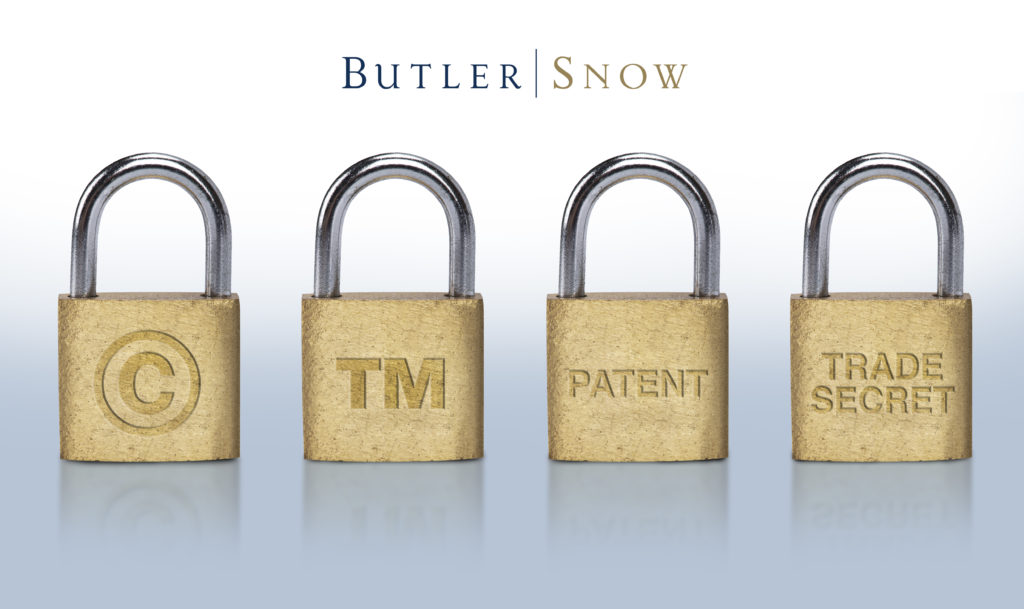Recently, high level policy changes with intellectual property (IP) have been taking place on a wide scale. When considering intellectual property protection, it is important to understand the different types of intellectual property, be aware of IP rights, as well as consider what legal mechanisms protect intellectual property. The legal landscape behind IP is currently changing and consists of several risks when it comes to protecting assets. It is incredibly important to use specialized legal counsel in order to properly navigate this terrain to ensure a successful process.
Key Considerations When Protecting IP
In this post we’ll discuss one of the most common reasons people or companies seek legal counsel: when something they’ve done has been infringed or someone else is infringing on their IP. At this point, the client is already involved in the legal aspects of fighting infringement laws and in need of some support. Situations like these underscore the importance of having a front-end IP strategy and building legal counsel into your budget to help navigate the process of protecting your assets more seamlessly.
Securing intellectual property protection essentially allows you to have a preliminary defense in place should you run into infringement issues later on and to enforce your rights against third parties. Utilizing proactive approaches will not only save time but also money. It makes sense to invest in a few hours of attorney time versus hours of legal fees to fix something that could have been avoided with the right forefront consideration. When claims do arise, there are aggressive timelines sometimes requiring a response within days that can cause disruption externally and also internally for the company in question.
Thus, there are very real business benefits to a strong IP strategy. By taking these initial steps, companies can block competitive products and potentially capture a larger market share. Examples of IP include: a trademark for your name, design patent of how your product looks, utility patents about the methods of use or composition of the product itself. The initial foothold is essential to having a clearer understanding of the landscape and hopefully reducing risk of infringement or legal action moving forward.
Following, we’ll discuss the steps to help safeguard your IP. The first step to protecting your intellectual property is wanting to make sure initial disclosures are limited and protected.
Make Sure Proper Disclosures Are In Place
Before discussing a new product, product name, logo or design you want to outline the disclosure so it is legally protected in some way. This goes for internal discussions within the company as well. For example, if you plan on disclosing an idea, name or something else that could qualify as intellectual property to an employee, you should make sure confidentiality is outlined within the scope of the employee contract.
If you’re disclosing to third parties, you will need to have a Non-Disclosure Agreement (NDA) in place ahead of time. This means there is a confidentiality agreement which will ensure any disclosure or content discussed surrounding the idea or invention between a company or individual and third party is protected by a contractual agreement. It is important how you identify content in that proposed transaction to ensure there are no exceptions or room for the third party to say that the non-disclosure agreement does not apply. Knowing IP rights is essential here. You must properly disclose information around intellectual property so that it cannot be considered public knowledge in the eyes of a court or government agency, which can lead to potential loss of rights under different types of IP laws. In addition, there can be numerous types of IP embodied by one “widget” so you will need an attorney to properly identify what legal mechanisms protect intellectual property as well as what the different types of IP may be available.
Identify The Type of Intellectual Property You Need
There are four main types of intellectual property: trademarks, copyrights, patents, and trade secrets. Each of these come with their own set of rules and regulations for obtaining IP registrations and filing applications correctly. Once confidentiality obligations are in place, you’ll need to identify which IP(s) you’ll be needing to protect in order to move forward in this process.
Trademark
A trademark is a name, logo or symbol—some type of identification of origin of the sources of goods or services. In the minds of consumers, it identifies that good or service with the brand. For instance, the Olympic rings logo represents the Olympics that identifies the sport services offered by the Olympics to consumers. Another example is Nike’s swoosh, the logo identifying that a shoe or offering is a Nike product. While names and symbols are the most common, a trademark can also be a sound or color. T-Mobile’s magenta is a trademark color and the NBC chimes are a trademark sound.
Copyrights
Copyrights cover an original creative expression or work of authorship. They are created upon the work of authorship being fixed in a tangible medium. For example, copyright protection occurs when the original work of authorship is fixed in tangible medium, such as written down on paper, whereas trademarks and patents typically require use in commerce or registration of some kind. Copyrights can be works of art, sculptures, written code, different written or artistic works. These must be demonstrated outside of your mind to qualify as intellectual property.
Patents
Unlike copyrights, patents can be ideas and grant limited monopolies to exploit inventions. A patent is a document issued by the United States Patent and Trademark Office (USPTO) where you have a limited duration to exploit that invention in exchange for that disclosure. It becomes public domain after the patent expires. Patents can take 3–5 years to obtain, a sometimes lengthy process when trying to protect IP.
There are two types of patents: utility and design. Utility patents are the most well-known and cover a new or improved and useful product, process, or machine. Design patents, on the other hand, cover the unique visual qualities of a product. One example is when you have a widget, design patents would protect the unique visual qualities of the widget, and a utility patent would protect the composition or method of using the widget.
Trade Secrets
Trade secrets are commercial information with economic value that is not generally known by others and is treated by the owner as a secret. Trade secrets can lose their designation as such if the owner shares them without the right precautions in place. For information that is difficult to patent, keeping the information, such as algorithms, as trade secrets can be an easier way to protect that IP versus disclosing it in a patent application that is published. Unlike patents, trade secrets do not require a registration. As technology continues to change rapidly, we are seeing a shift in entities applying for patent protection to marking IP as trade secrets for immediate protection.
Now, It’s Time to Run an IP Search
Legal consultants will conduct IP searches to see if you are at risk on the front end for using that name, logo, or invention improperly. This helps to avoid causing infringement before you’re even aware of making this mistake. Infringement can occur on several levels, and it can start building damages with something as simple as an intern using an image on your company website or social channels, if the copyright in the photo is not owned by you or your company.
Understanding the Final Process of Filing
For trademarks and patents, it is generally expected that you will receive an initial rejection whether it is substantive or not. Legal consultants will help you navigate the options for response, potential fees, considerations for extensions, etc. The suggested strategy may include business decisions, such as reaching out to a third party with related IP or having an interview with a patent or trademark examiner. Patents require representation by a patent lawyer, who is required to pass a separate certification. Butler Snow’s IP practice includes licensed patent lawyers. Not all trademark applicants are required to be represented by an attorney before the USPTO. However, in its Trademark Basics, the USPTO has identified the following benefits of hiring a trademark attorney to assist with your trademark application:
- Providing you crucial legal advice about your trademark.
- Conducting your trademark clearance search before you file an application.
- Preparing your application accurately.
- Responding to legal correspondence from the USPTO.
- Enforcing and maintaining your trademark rights.
- Representing you at the USPTO’s Trademark Trial and Appeal Board.
- Shielding you from fraudulent solicitations.
Working with Legal Counsel on IP Strategy
Legal consultants can offer navigation, strategy, and clear understanding of rights that are difficult to identify when companies are operating in the murky space of intangible property. They can help secure proper protection as well as strategize what content should be protected and how to avoid potential future risk of infringement. It is also important to be aware of filing requirements and meet deadlines for intellectual property applications and registration maintenance.
Additionally, legal consultants involved in preliminary strategy will help ensure you’ve included the content necessary for a patent application before the application is published. Your legal team can also run IP searches to give you a better idea of relevant types of intellectual property and third-party registrations and publications enabling you to make an educated decision when moving forward with different types of protections.
Once legal consultants have identified the risks associated attempting to use and protect your intellectual property based on the results of those searches, they will give advice on how to move forward. This is an important step as data from the preliminary search results can help determine the likelihood of rejections, confusions, or arguments needed for acceptance when it comes to trademarks or patents. For instance, during this stage a legal partner may find other patents or published literature closely related to a client’s proposed invention. Those existing patents could prevent you from obtaining a registration if too closely related to your proposed invention. A legal consultant can streamline this process by assessing the risks, hurdles, and chance of success when obtaining registration.
In Part II of this series, we’ll cover what actions can be taken if your intellectual property has been infringed upon.
